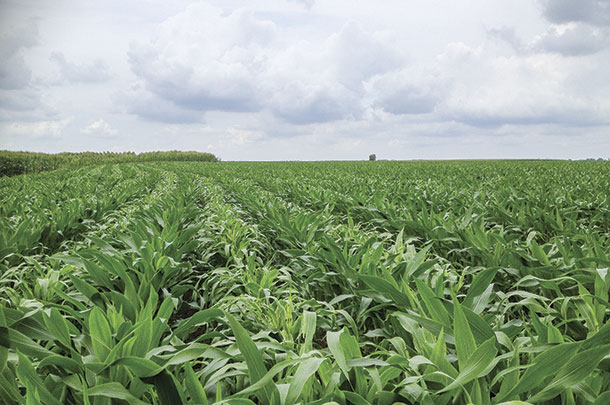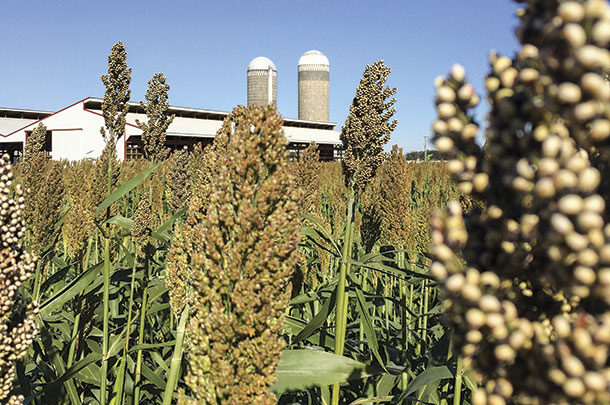Moreover, sorghums continue to gain attention from a variety of places, including shifts in overseas requirements, rising interest among consumers for gluten-free ingredients and changes in weather patterns encouraging use of water-friendly crops.
The sorghum industry has long argued the benefits of adding warm-season crops into traditional forage rotations and silage systems. (And I contend even 10 percent summer annuals mixed with other cool-season forages makes agronomic sense and spreads out the risk from adverse weather conditions.) We are often asked both how to use forage sorghums and how they compare to corn silage.
Forage sorghum 101
Planting sorghums should be delayed until soil temperatures reach 65ºF at 2 to 4 inches deep. Planting too early can lead to stand problems, as sorghums are not as tolerable to cool soil conditions or where heavy residue is present.
Sorghum’s smaller seed size and high temperature requirements often result in slower seed emergence and lower seedling vigor compared to corn. However, forage sorghums take off in summer when temperatures rise and moisture is less likely.
Planters should be set to place seed around 1 to 2 inches deep, depending on soil type and moisture. Seeding rates vary based on row width, hybrid selection and seed size, with typical rates falling between 4 and 10 pounds per acre.
Given the assumption forage sorghum emergence normally averages 80 to 85 percent, this equates to a planting population of 60,000 to 120,000 plants per acre. Keep in mind, forage sorghum can be planted with the same equipment as corn (using a milo/sorghum plate or drum depending on planter). Planting in rows allows for easier harvest and cultivation should weed control be needed.

Proper fertility is crucial for growing forage sorghum. Across most of the Midwest, phosphorus and potassium levels needed for forage sorghum should compare to that of corn silage. Nitrogen (N) is different, however. Our team describes N needs this way: For every day the sorghum plant is growing, assume it needs between 1 and 1.25 pounds of actual N.
Take caution when adding N; some starter fertilizers can cause injury in narrow row environments, and side-dressing N into sorghum can cause root pruning. It is important to maintain an N-to-sulfur ratio close to 5-to-1. This helps the plant more efficiently convert N to protein (and thus keeps toxic nitrate concentrations at bay within the plant).
Nitrates can be an issue, just as they are in corn silage. Ensiling reduces nitrate content; however, this takes time. A simple recommendation is to leave more stalk at harvest because nitrates accumulate in the lower part of the plant.
There is also potential for prussic acid toxicity with sorghums; however, the risks are much less when harvested as silage. Prussic acid levels will dissipate during the harvesting and ensiling process (usually after only a couple weeks).
Herbicides for forage sorghum are limited basically to 2,4-D, atrazine, metalochlor and bromoxynil. To apply metalochlor, sorghum seed must be treated with a seed safener. With the uptick in sorghum use across the country, safened seed availability is very common, now becoming the norm versus seed untreated.
Metalochlor, along with atrazine, is a highly effective pre-emergence herbicide system. Whereas 2,4-D can be used early post-emergence for limited broadleaf control, there are no post-emergence grass herbicides labeled for forage sorghum.
Keep in mind, row cultivation is an effective option when sorghum is planted in rows. However, the best weed control strategy is often starting with a clean seedbed and doing everything possible to quickly establish the stand, shading the soil and out-competing weeds for sunlight and water.
General advantages
- Forage sorghums boast extreme drought tolerance and high water-use efficiency (40 percent less water than corn). Sorghum and sorghum-sudangrass contribute 1.75 to 2.5 tons of biomass per 1 inch of water (irrigated) compared to corn at less than 1 ton of biomass per inch of water (Texas Cooperative Extension, 2001).
- Forage sorghums have much lower nitrogen requirements – about 40 percent less N use than that of corn.
- Sorghums maintain productivity up to 104ºF as compared to corn, which shuts down at 85ºF.
- Though very palatable, deer will not bother forage sorghums in the vegetative stage. This makes forage sorghum a viable option in fields where deer are consistently bothering growing corn, locations that typically wind up being used for silage corn anyway.
Harvest and feeding
Forage sorghum is best used as a silage crop, although it can be cut for hay and even grazed if properly managed. It is best suited for one-time-cut systems in much of the northern U.S. Important steps to maintain sorghum silage quality are:
- Harvest at the proper moisture (yield and quality are maximized between 65 and 75 percent water); this is usually at the soft dough stage of development.
- For conventional forage sorghum, keep chop length uniform (around 0.5 inch) and, for BMR forage sorghum, 0.75 to 1 inch – a recutter screen may be needed to crack kernels if the crop is very dry.
- Fill the silo or bunker quickly and pack the silage accordingly.
Digestibility with conventional forage sorghum is usually less than that of corn, a function of lignin and starch (or grain). Less grain produced by sorghum can lead to lower starch production. However, a key consideration when replacing corn silage with sorghum silage is to think fiber and not dry matter.
BMR hybrids contain less lignin (in both the leaves and stalks) and thus have higher digestibility, often surpassing corn in neutral detergent fiber digestibility and energy. BMRs work great for animals needing more energy, assuming it is harvested and managed properly.
Whole-plant forage sorghum silage has lower starch digestibility because its kernels are hard and often go unprocessed through the animal. Then again, harvesting early at the soft dough stage can also minimize this deficiency.
Photoperiod-sensitive sorghums are also available. These hybrids remain vegetative (and not seed-producing) until day length is fewer than 12 hours and 20 minutes, which gives extended flexibility in managing harvest.
However, these hybrids will likely need to be cut and wilted, rather than direct-chopped, to allow the high moisture levels to dissipate prior to removal from the field.
Conventional forage sorghum will work for many classes of livestock, like heifers and dry cows. These animals have lower energy requirements than lactating animals. However, many of today’s BMR forage sorghums are successfully being used in many high-producing dairy rations across the U.S. Alongside supplements, forage sorghum can provide a nearly complete ration.
We combined information on typical agronomic summer annual management practices with nutrient removal rates from several sources across the Midwest to develop a simple calculator.
It presents a compelling argument to consider planting forage sorghum on at least a portion of a producer’s farm – based on input costs. In vitro true digestibility was added to provide a comparison showing forage quality from properly managed forage sorghums – specifically BMR hybrids – rivals that of traditional silage produced from corn.
Yellow boxes in the calculator require input from the user. Seed and fertilizer costs, as well as tonnage goals, also need to be inserted by the user. The results show the comparison in costs and output efficiency. The results might be surprising. (Go to comparing costs of forage to access the calculator.)
As stated earlier, summer-annual forages like forage sorghum produce the same dry matter on much less moisture than it takes to raise corn silage. It makes sense and helps minimize risk to add these forage crops to a forage plan in any year. But in a dry year, especially, if summer annuals are not part of the crop plan, producers may wish they were. ![]()
PHOTO 1: Forage sorghum nears maturity.
PHOTO 2: Corn and sorghum-sudangrass are planted side by side. Photos courtesy of La Crosse Seed.

-
Scott Wohltman
- Cover Crop Lead
- La Crosse Seed
- Email Scott Wohltman











